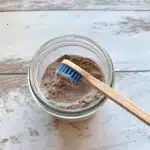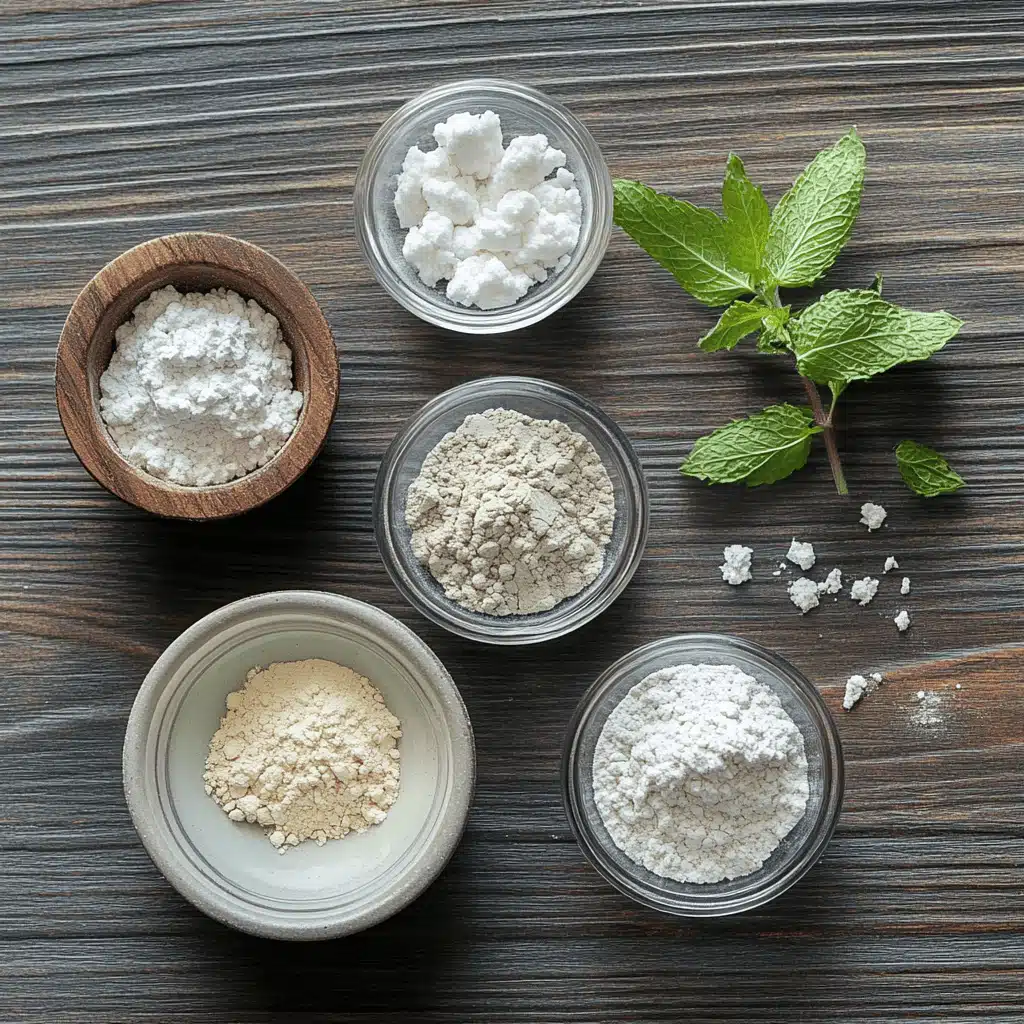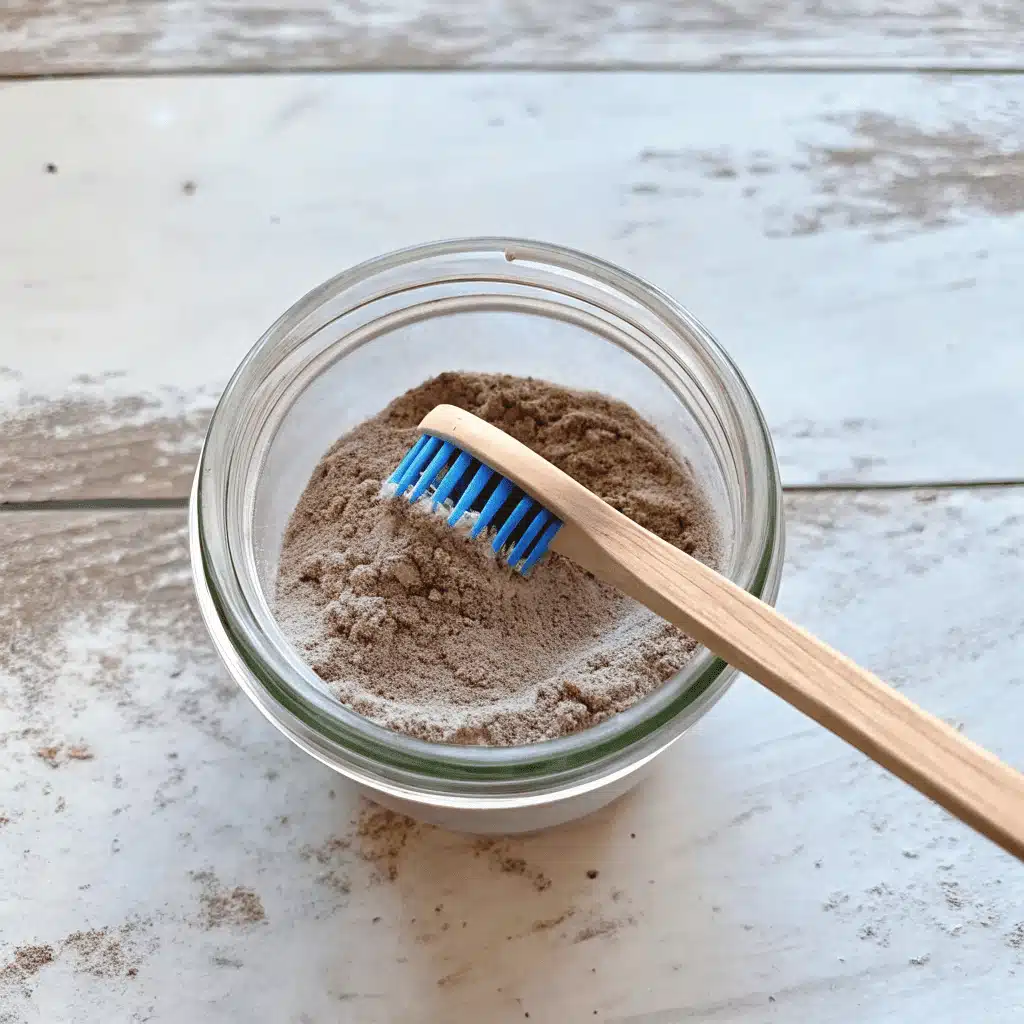A Homestead Morning with Natural Tooth Care
Some mornings start slow here in the Catskills. I sip coffee from a chipped enamel mug while the sun glints off the dew-covered garden. But this one started with a jar of baking soda, a scoop of bentonite clay, and the curiosity that comes from years of wanting to make do with what I have. The moment I stirred those pale powders together—watching the fine, mineral-rich dust swirl like fog—I knew I’d found something worth keeping: a simple, effective powdered toothpaste recipe.
I’d run out of commercial toothpaste the night before. Normally, that would’ve meant a run to town. But I had my pantry, and years of trust in the ingredients inside it. I’d already used baking soda to freshen rugs and unclog drains—why not put that same power to work on my teeth? After all, this stuff works magic on a grimy sink with just a splash of vinegar. If you haven’t seen what happens when baking soda and vinegar clean a drain, you’re missing out on one of life’s small thrills.
That morning, I made something more than just a DIY tooth cleaner. I made a shift. This powdered toothpaste recipe quickly became a staple in our home. It’s easy to mix, costs almost nothing, and—most importantly—it fits my values. No plastic tube, no questionable ingredients, no fluff. Just tooth powder and a quiet sense of satisfaction every time I brush.
And here’s the truth: once you try it, you’ll wonder why you ever needed those minty gels at all.
Table of Contents

Powdered Toothpaste Recipe: A Simple, Sustainable Way to Clean Your Teeth
- Total Time: 5 minutes
- Yield: 1 small jar (2–3 months supply) 1x
Description
Homemade powdered toothpaste recipe made from bentonite clay, baking soda, and optional flavorings. Long shelf life, eco-friendly, and travel-ready.
Ingredients
3 tbsp baking soda 2 tbsp bentonite clay 1 tbsp calcium carbonate (optional) 1/2 tsp clove powder or 5 drops peppermint essential oil 1/2 tsp activated charcoal (optional)
Instructions
1. Combine dry ingredients in a non-metal bowl. 2. Add essential oils (if using) and stir thoroughly. 3. Store mixture in a glass jar with airtight lid. 4. Use dry toothbrush to dip into the powder. 5. Brush as usual and rinse.
Notes
Avoid metal bowls or utensils when working with bentonite clay. Keep powder dry to extend shelf life. Store in a cool, dark place.
- Prep Time: 5 minutes
- Cook Time: 0 minutes
- Category: Oral Care
- Method: No-cook
- Cuisine: DIY / Natural
Nutrition
- Serving Size: 1 tsp
- Calories: 0
- Sugar: 0
- Sodium: 0
- Fat: 0
- Saturated Fat: 0
- Unsaturated Fat: 0
- Trans Fat: 0
- Carbohydrates: 0
- Fiber: 0
- Protein: 0
- Cholesterol: 0
Keywords: powdered toothpaste recipe, homemade toothpaste, DIY oral care
Why Make a Powdered Toothpaste Recipe?
When you live close to the land like I do, you learn to keep things simple. My powdered toothpaste recipe is about as straightforward as it gets, made from ingredients I already trust around my home. Bentonite clay draws out impurities and helps with that silky-clean feel after brushing. Baking soda gently scrubs away surface stains and freshens your breath. Add a few drops of peppermint or clove if you want, and that’s about it.
Powdered toothpaste isn’t just a backup for when you run out of the store-bought stuff. It’s shelf-stable, travel-friendly, and naturally anti-microbial—meaning it lasts far longer than homemade pastes that can spoil. Kept dry in a glass jar, it can easily stay fresh for a year. It also doesn’t require preservatives or fillers.
And if you’re already using baking soda to clean carpets (like in my baking soda carpet refresher), then you know how versatile this one ingredient can be. It’s no leap to see it working just as well in your mouth.
But more than all that, making your own powdered toothpaste recipe just feels right. It puts the power back in your hands. No plastic. No nonsense. Just a jar, a spoon, and a little know-how.
Ingredients & Preparation — What Goes Into Tooth Powder

Key Ingredients and Their Benefits
What I love about crafting a powdered toothpaste recipe is how it takes just a few trusted ingredients to get results that rival anything in a plastic tube. Each part of the blend plays a role, and when you understand why they’re there, the recipe feels even more worthwhile.
Baking soda is the foundation of any good powdered toothpaste recipe. It’s mildly abrasive, helping scrub away plaque while balancing pH. If you’ve used it for cleaning carpets or deodorizing a room—like I show in my baking soda carpet refresher—you know it’s dependable. On your teeth, it does the same: clean, fresh, and no residue.
Bentonite clay is next. Rich in minerals like calcium, magnesium, and silica, it draws out toxins without damaging enamel. It gives the tooth powder its silky texture and cleansing feel. I use it regularly in natural cleaning and beauty blends, and it’s always a key player in my go-to powdered toothpaste recipe.
Calcium carbonate is optional, but I like to include it. This white powder helps gently polish and support enamel strength, especially for folks looking to remineralize naturally. It brings structure and body to your tooth powder, too.
For flavor and extra benefits, I add clove powder or peppermint essential oil. Clove has a subtle spice and antimicrobial qualities, while peppermint brings that familiar freshness. Either one works beautifully in this powdered toothpaste recipe.
Some versions also include activated charcoal, which is excellent for tackling surface stains. Use it in small amounts, and be mindful not to rely on it daily, as it’s more abrasive than baking soda or clay.
You can find a similar blend in my natural toothpaste recipe, but this powdered form has the advantage of longer shelf life and zero spoilage risk—perfect for homestead pantries and travel kits alike.
How to Make Powdered Toothpaste Step by Step
The beauty of this powdered toothpaste recipe is that it’s ready in five minutes flat. All you need is a few simple pantry staples and a small jar.
Start with three tablespoons of baking soda, then add two tablespoons of bentonite clay. If you’re including calcium carbonate, add one tablespoon. Mix in a half-teaspoon of clove powder or 4–5 drops of peppermint oil, and a pinch of activated charcoal if you want whitening benefits.
Combine everything in a non-metal bowl using a wooden or plastic spoon—bentonite clay reacts to metal and loses its detoxifying power. Stir gently until evenly mixed.
Transfer your homemade powdered toothpaste recipe into a clean glass jar with a tight lid. I like to keep mine near the sink in an old spice jar with a shaker top—it makes daily use super convenient.
To use, dip a dry toothbrush into the powder or sprinkle a small amount into the palm of your hand. Brush as usual. The powder turns paste-like in your mouth, giving you a clean, polished feel.
If you’ve brushed with baking soda alone before, like I describe in how to brush teeth with baking soda, this recipe takes it to a whole new level. The added clay and optional oils make it gentler, fresher, and more enjoyable to use long term.
This powdered toothpaste recipe is simple, safe, and long-lasting. It reflects the same values I hold for everything I make: waste less, use what you have, and trust the ingredients under your roof.
Use, Benefits & Shelf Life of Tooth Powder

How to Use Powdered Toothpaste Correctly
Using a powdered toothpaste recipe is a little different at first, but once you get used to it, it’s as natural as picking herbs from the garden. There’s no squeezing tubes or fiddling with caps—just a clean dip, brush, and rinse.
To use, start with a dry toothbrush. Simply dip the bristles into the powder jar or tap a small amount into the palm of your hand. A pea-sized sprinkle is more than enough. As you begin to brush, the powder mixes with your saliva to form a light paste that spreads easily across your teeth.
Brush just like you normally would. Small, gentle circles along the gumline, and don’t forget the back molars. I’ve found that my powdered toothpaste recipe leaves my teeth feeling smoother and cleaner than many store-bought options ever did.
Be sure to keep moisture out of the jar—wet brushes can cause clumping or spoilage. If you’re sharing the powder with family members, consider portioning it out into smaller jars or using a clean, dry spoon for scooping.
For folks who’ve already explored how to brush teeth with baking soda, this will feel familiar—but far more complete. Adding bentonite clay and natural flavor oils gives your teeth a deeper clean, without harshness or artificial aftertaste.
You can use this recipe daily, but if your teeth or gums are especially sensitive, try brushing once a day with the powder and once with water or a soft herbal rinse. Everyone’s mouth is different, and part of the homestead mindset is listening to what your body tells you.
How Long Does Homemade Tooth Powder Last?
One of the biggest perks of using a powdered toothpaste recipe is the shelf life. Unlike homemade pastes, which can go bad in just a few weeks, tooth powder keeps for months—even a year—if stored properly.
Dryness is the secret. Because the powder doesn’t contain any water or oil, bacteria can’t easily grow. This makes it perfect for bulk prepping, especially if you’re stocking an off-grid cabin, travel bag, or emergency kit.
Always store your homemade powdered toothpaste recipe in an airtight container. I prefer glass jars with screw-top lids, but even metal tins work if you’re not using bentonite clay. (Clay can react with metal, so if that’s part of your mix, stick to glass or plastic.)
Humidity is your biggest enemy here. Keep your jar in a cool, dry place—definitely not beside the steamy shower. If you do see clumping or moisture, toss the batch and start fresh. The ingredients are inexpensive, and your mouth deserves the best.
Just like with your home cleaning blends—think of how you preserve your baking soda carpet powder by sealing it tight—the same rule applies here. A dry mix is a long-lasting mix.
A well-made powdered toothpaste recipe is more than a DIY project—it’s a long-term solution for folks who want control over what goes into their bodies. It’s sustainable, safe, and smart.
Common Questions & Creative Variations
Can You Brush Teeth with Just Bentonite Clay?
You can—but should you? Bentonite clay is one of the safest and most mineral-rich ingredients in any powdered toothpaste recipe, and brushing with it alone can help remove toxins and polish your teeth gently. That said, it works best when paired with other ingredients like baking soda or calcium carbonate.
On its own, bentonite clay lacks the effervescence and deep-cleaning ability of baking soda. Think of it like using just vinegar without the fizzing help of baking soda in your baking soda and vinegar drain cleaner—you get part of the job done, but not all of it.
For occasional use or detox-focused brushing, plain bentonite clay is fine. But for daily dental care, your mouth benefits more from a complete powdered toothpaste recipe that includes multiple supporting ingredients.
If you want the benefits of clay and also enjoy a little freshness and polish, blend in some peppermint oil or a touch of clove powder. You’ll notice the difference after just a few brushes.
Popular Tooth Powder Variations to Try
Once you’ve mastered the basic powdered toothpaste recipe, it’s fun to experiment with variations that fit your needs or preferences. That’s one of the joys of homestead living—adapting the basics to fit your family.
Here are a few variations you might enjoy:
- Whitening Blend: Add a small amount of activated charcoal and a pinch of sea salt.
- Kids’ Version: Try cinnamon or orange essential oil instead of mint for a gentler flavor.
- Remineralizing Mix: Increase calcium carbonate and add a bit of magnesium powder.
- Coconut Blend: Combine with a bit of powdered coconut milk for extra smoothness (use only in very dry storage conditions).
The beauty of a powdered toothpaste recipe is that it’s shelf-stable and customizable. You’re not locked into a formula. You can change it as the seasons shift, or when you find a new favorite herb or oil to try. Much like in my natural toothpaste recipe, flexibility is what makes it sustainable.
Remember, if you’re trying something new—whether it’s adding essential oils or using charcoal—always test a small batch first. Your mouth will tell you quickly if something isn’t working.
Frequently Asked Questions (FAQ)
How to make your own powdered toothpaste?
To make your own powdered toothpaste, mix baking soda, bentonite clay, and calcium carbonate in a non-metal bowl. Add clove powder or peppermint oil for flavor. Store in a dry glass jar and use a dry toothbrush to apply.
What is Just Ingredients tooth powder?
Just Ingredients is a commercial brand offering clay-based tooth powders with natural flavorings and essential oils. The homemade powdered toothpaste recipe above mirrors many of those same ingredients at a fraction of the cost.
How long does homemade tooth powder last?
When kept dry in an airtight container, homemade tooth powder can last up to one year. Avoid moisture, and never dip a wet brush into the powder jar.
Can I brush my teeth with just bentonite clay?
Yes, but it’s better when mixed with other ingredients like baking soda. Alone, bentonite clay gently cleanses, but it lacks the deodorizing and whitening action of a full powdered toothpaste recipe.
Conclusion
A good powdered toothpaste recipe is more than a kitchen experiment—it’s a quiet rebellion against waste, plastic, and unknown chemicals. It fits in a mason jar, costs pennies, and keeps your teeth clean using ingredients you already trust in your home.
This is one of those small lifestyle swaps that brings big satisfaction. You’ll spend less, waste less, and feel better knowing exactly what’s going into your mouth every day. And just like that, one more little thing in your life becomes yours again—made by hand, with care, and a little scoop of homemade magic.
📌 Follow along or tag me here:
Facebook: Recipes NYC on Facebook
Pinterest: @Recipes_NYC on Pinterest
Medium: https://medium.com/@recipesnyc

